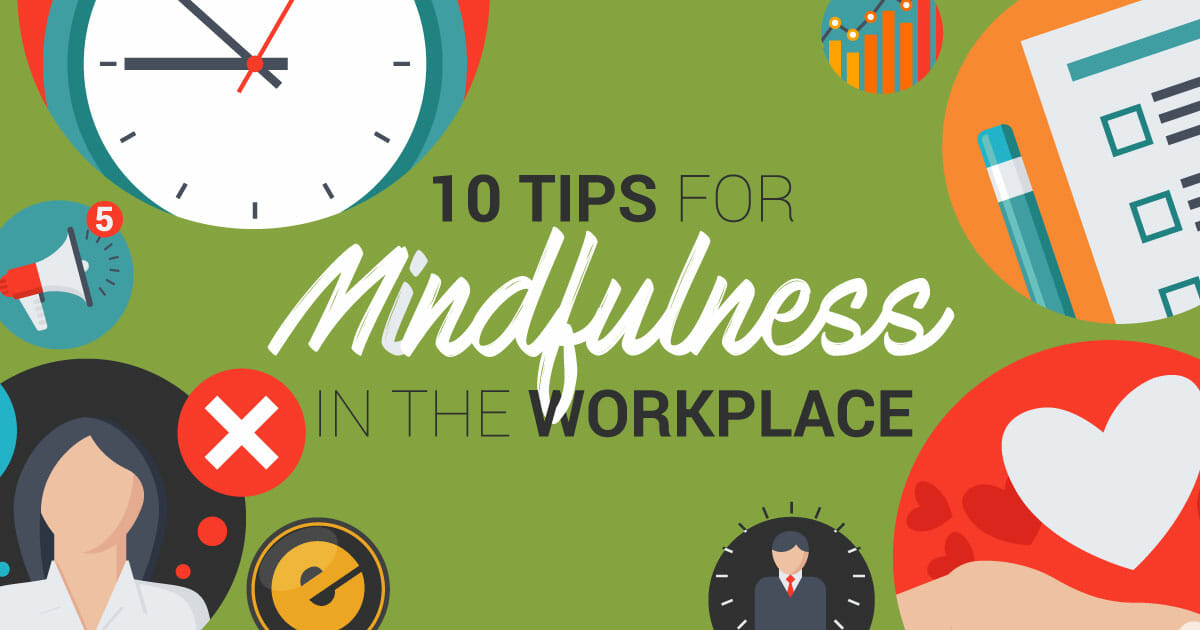First, let’s start with a quick definition of mindfulness before we get all gung-ho about it:
So, basically, it’s being in the moment, focused on the here and now. That is not an easy feat with deadlines looming over your shoulder like a fasting vampire breathing on your neck. Now that you have that visual in your mind, let’s get back to the topic at hand: mindfulness in the workplace.
Deadlines, emails, phone calls, meetings, more emails, presentations … no, don’t run from your desk! Keep reading!
You must be asking yourself how can you possibly consider applying the principles of mindfulness so that you feel less zombie-like and more alive, as well as becoming more productive. Here are a few ideas to get you started on your journey to being mindful at work:
1. Be Consciously Present

- You notice what’s going on around you.
- You notice what’s going on within you.
Being mindful at work means to be aware of, at all times, in that moment, what you are doing while you are doing it. It also involves managing your mental and emotional state. If you are creating a proposal or a report for the big cheese or the little guy, mindfulness requires that you give it your full attention.
Each time your mind wanders to things like that funny cat video you watched or what you read on Facebook about the Kardashians, acknowledge the thoughts and then bring your mind back to the task at hand.
Here are a few tips to change mindlessness into mindfulness and increase your productivity:
-
- Make a clear decision at the beginning of your workday: Begin with a clear idea of what you wish to accomplish.
- Slow and steady wins the race: While you become used to the practice of mindfulness, you may find you work a little slower at first, but it will pay off in the long run.
- Remember WHY you are doing this: Keeping the why in mind helps motivate you to keep going.
- Give your undivided attention to every task: Yes, even the mundane, everyday tasks such as opening the door, pouring that third cup of coffee, or even breathing while you wait for a meeting to start.
2. Make Use of Short, Mindful Exercises

No closing your eyes, no sitting down: just 60 seconds realigning your thoughts. Be creative and find time throughout your day to do these exercises. Have a few more minutes? Fantastic!
Barely have time to breathe between calls? That’s fine, too. These short exercises are important. They help you rebalance your nervous system, reduce your fight-or-flight response, and reinvigorate the “wise” part of your brain so on the next call you will be calm, clear and focused on winning that new client.
3. One Thing at a Time

Multitasking is really just switching back and forth really fast, and in most cases, losing data in the process. Multitasking is inefficient, and yet we continue to do it. In fact, there are studies that have shown the more you multitask, the more addicted to it you become.
So let’s kick that habit and become a mindfulness bad ass. Here are a few tips to get you started:
Try a Time Journal
Track what you are accomplishing in a block of time, and note when you were single-tasking or multitasking. Add what you achieved in that time frame and how mindful you were.
Try Categorizing Tasks
Group together your tasks to accomplish in one block of time. Put emails, phone calls, errands and meetings together. Rather than jumping around, use the dedicated time.
Remove Distractions
Silence the phone, log off email, remove Facebook pop-ups, mute your work chat. Now, set a timer and work undistracted. At the end of that time, check what you need to – emails, chat, etc. Do what works for you to focus on the single task for the allotted time.
Remember Your Mindfulness Exercises
Between tasks, get up, stretch, take deep breaths, go for a walk or listen to a guided breathing exercise, such as this.
4. Use Reminders and Alerts

Autopilot means you are not 100 percent present in the moment, and that you are barely aware that the moment is in front of you. You can’t be creative, plan or respond properly if you are operating on low power. You just can’t do it, Captain. You don’t have the power!
So let’s give you back the power! Try these tips:
- Use alarms on your phone: Do this even if your phone is on vibrate so that it’s not driving your coworkers crazy.
- Use your calendar: Set appointments with yourself.
- Add some art: Keep a small note or a picture on your desk to remind you to be mindful.
5. Slow Down to Speed Up

Here is another way to look at it: You can no longer sleep; you need to work, because sleeping isn’t working and there is too much to do. So, just stop sleeping. After a while, you just don’t function any more and you are no longer living in the moment, but in the hallucinations of your sleep-deprived mind.
So, you can see how you need sleep to work, and sleep is rest. Rest is good. Your brain needs breaks to regroup and become more efficient.
That panicky rush to hit a deadline leads to mistakes, poor decisions and wasted energy. So, stop. Breathe deeply. Now, focus on listening. Walk, don’t run. And take your time to be mindful.
6. Stress Is Your Friend … Really!

So, if you are part of the second group, you should be going, “Holy cow, I gotta change my ways!” Mindfulness can help you change your views. When you encounter a stressful situation at work, take a moment to reflect on your reaction, your heart rate, your blood pressure, your attitude.
Having your pulse increase increases the oxygen in your blood, and gears you up for the challenge ahead. Treat it more like getting ready for an Ironman Challenge rather than the Dread Pirate Roberts. You aren’t going to your death: You are rising to the challenge and you will come out on top.
This change of view can LITERALLY add years to your life and improve your productivity in the workplace.
7. Adopt an Attitude of Gratitude

To counter this, you must develop an attitude of gratitude. Find your silver lining, however small it may be. This will lead to more silver linings, which will give way to silver clouds and then blue skies. To get there, practicing mindfulness in all aspects of life and work helps improve your resilience to the downward spiral that is negativity.
Not happy at work? Find something to be thankful for – maybe your paycheck. It may not be the paycheck you would like, but it’s better than no check. And, I am sure you like at least one person there, one person who makes you smile. If nothing else, the job gives you insight into what you are looking for in a career – things you want and don’t want. So, be grateful for the experiences and lessons the job teaches.
8. More Humble, Less Grumble

Don’t confuse humility with meekness or timidity. They are in no way the same thing. To be humble doesn’t mean that you see yourself as inferior, but rather you are aware of your natural dependence and your equity in those around you.
Humility and mindfulness work very closely together. You can even say they are intimate. Mindfulness is accepting who you are and being open to listening and learning from those around you. You are grateful for them and the lessons they share. And someone who is grateful for others is also naturally humble.
Need a little humility in your life? Try these:
- Practice your mindful exercises.
- Spend a few minutes every day thanking those who have helped you – even if it is silent, in your heart or prayer.
- Show appreciation: Say thank you!
- Value other people’s opinions.
9. Like the Serenity Prayer, Accept What You Cannot Change

At work, if you missed a deadline, accept it. It came and went, and you weren’t ready. As soon as you accept that, you can come to a solution, talk to the team, learn from the mistake and move on. Acceptance leads to change.
Personal acceptance is infinitely more powerful. Embrace your shortcomings, weaknesses, strong points, aspects you do and don’t admire: They make you who you are. This acceptance will lead to confidence, clarity and joy. No longer will you be stuck with energy draining self-criticism, but you will have set the stage for greater peace of mind, productivity and mindful moments.
10. Think ‘Growth’ in Everything

Mindfulness is about developing a growth mindset. It’s about giving full attention to the moment right now – with no judgments – and being open to new possibilities. Your new mindfulness outlook will make receiving negative reviews easier: You will see them as an opportunity to grow, instead of as an attack. You will be willing to take on new responsibilities and challenges because you will be curious to see how you can handle it all.
Mindfulness in the Workplace Can Bring About a New You
Through this mindfulness journey, you will discover new things about yourself, your work and your attitude. Take baby steps. Rome wasn’t built in a day, nor will you master mindfulness in one go.





I guess I need to work on #2 …….. a lot
Don’t we all!
Being mindful is so important! Great post!
Thanks for reading! Kirstin did a good job, huh?
Very nice article! It is so important to think about these things, but sometimes you just work work work and forget all about it. Thanks for the reminder Kirstin!
Thanks for reading! Glad you enjoyed!
A pliagensly rational answer. Good to hear from you.
Love the ideas of being humble and adopting an attitude of gratitude. So many people in this day and age feel like they are owed something and become frustrated when the world doesn’t give it to them. If you are thankful for everything you receive then nothing will phase you. Thanks for sharing these tips!
Agreed. Entitlement is extremely frustrating! You are so right about being thankful and nothing will phase you. You open yourself up to so many opportunities and growth. Glad you enjoyed the article:)
Very interesting point about viewing stress as a positive thing. I guess, as long as it is not a question of life and death, challenges at work can be viewed as a way to improve your productivity and creative thinking.
This post didn’t mention it, but what really helps me in a stressful situation is calling a friend or a family member. Just a few minutes of casual conversation with someone I love brings me into a good mood.
That is a great way to manage negative stress or even relieve the tension of the good stress. It is good to have a solid support group to have your back during the good and bad.
stress is very bad for our life and we should try to never gain stress on ourselves